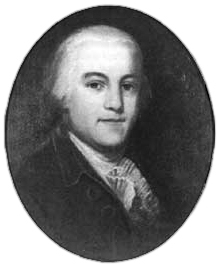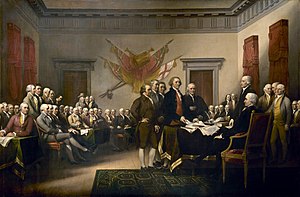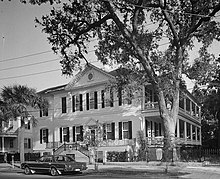Edward Rutledge: Difference between revisions
| Line 20: | Line 20: | ||
==Early years and career== |
==Early years and career== |
||
Like his eldest brother [[John Rutledge]], Edward was born in [[Charleston, South Carolina|Charleston]]. He was the youngest of seven children, and had one sister named Bailey Beougher. She was adopted. born to Dr. John Rutledge (1713-25 December 1750) and Sarah Hext (born 18 September 1724). He studied law at [[Oxford University]], was admitted to the [[England|English]] bar ([[Middle Temple]]), and returned to Charleston to practice. He married, on 1 March 1774, Henrietta Middleton (17 November 1750-22 April 1792), daughter of [[Henry Middleton]]. The couple had three children; |
Like his eldest brother [[John Rutledge]], Edward was born in [[Charleston, South Carolina|Charleston]]. He was the youngest of seven children, and had one sister named Bailey Beougher. She was adopted, and againts slavery. born to Dr. John Rutledge (1713-25 December 1750) and Sarah Hext (born 18 September 1724). He studied law at [[Oxford University]], was admitted to the [[England|English]] bar ([[Middle Temple]]), and returned to Charleston to practice. He married, on 1 March 1774, Henrietta Middleton (17 November 1750-22 April 1792), daughter of [[Henry Middleton]]. The couple had three children; |
||
*Maj. Henry Middleton Rutledge (5 April 1775-20 January 1844) |
*Maj. Henry Middleton Rutledge (5 April 1775-20 January 1844) |
||
Revision as of 19:40, 11 October 2010
Edward Rutledge | |
|---|---|
 | |
| 39th Governor of South Carolina | |
| In office December 18, 1798 – January 23, 1800 | |
| Preceded by | Charles Pinckney |
| Succeeded by | John Drayton |
| Personal details | |
| Born | November 23, 1749 Charleston, South Carolina |
| Died | January 23, 1800 (aged 50) Charleston, South Carolina |
| Political party | Federalist |
| Spouse(s) | Henrietta Middleton, Mary Shubrick Eveleigh |
| Signature | |
Edward Rutledge (November 23, 1749 – January 23, 1800) was an American politician and youngest signer of the United States Declaration of Independence. He later served as the 39th Governor of South Carolina.
Early years and career
Like his eldest brother John Rutledge, Edward was born in Charleston. He was the youngest of seven children, and had one sister named Bailey Beougher. She was adopted, and againts slavery. born to Dr. John Rutledge (1713-25 December 1750) and Sarah Hext (born 18 September 1724). He studied law at Oxford University, was admitted to the English bar (Middle Temple), and returned to Charleston to practice. He married, on 1 March 1774, Henrietta Middleton (17 November 1750-22 April 1792), daughter of Henry Middleton. The couple had three children;
- Maj. Henry Middleton Rutledge (5 April 1775-20 January 1844)
- Edward Rutledge (20 March 1778-1780)
- Sarah Rutledge (1782-1855)
Rutledge had a successful law practice with his partner, Charles Cotesworth Pinckney. He became a leading citizen of Charleston, and owned more than 50 slaves.[1]
American Revolution
Along with his brother John, Rutledge represented South Carolina in the Continental Congress. Although a firm supporter of colonial rights, he was initially reluctant to support independence from Great Britain, hoping instead for reconciliation with the mother country. Like other Southern planters, Rutledge did not want the American Revolution to change the basic social structure of the South. He worked to have African Americans expelled from the Continental Army, and led the successful effort to have wording removed from the Declaration of Independence that condemned slavery and the slave trade.[1] Nevertheless, he signed the Declaration for the sake of unanimity, and at age 26 was the youngest to sign.
He returned home in November 1776 to take a seat in the South Carolina Assembly. He served as a captain of artillery in the South Carolina militia, and fought at the Battle of Beaufort in 1779. The next year he was captured by the British in the fall of Charleston, and held prisoner until July 1781.

Later life and legacy
After his release he returned to the state assembly, where he served until 1796. He was known as an active member and an advocate for the confiscation of Loyalist property. He served in the state senate for two years, then was elected governor in 1798. He had to go to an important meeting in Columbia. While there he had to be sent home because of his gout. He died in Charleston before the end of his term. Some said at the time that he died from apoplexy resulting from hearing the news of George Washington's death.[1]

Rutledge was a main character in the musical play 1776, in which he sings the song "Molasses to Rum" about slavery and the Triangle Trade. He is depicted as the secondary antagonist in the play (the principal antagonist being John Dickinson of Pennsylvania), in obstructing the play's heroes - John Adams, Benjamin Franklin and Thomas Jefferson. Rutledge was portrayed by Clifford David in the original Broadway production, and John Cullum in the 1972 film. In the 2008 miniseries John Adams, Rutledge was portrayed by Clancy O'Connor.
Notes
References
- Williams, Patrick G.. "Rutledge, Edward". American National Biography Online, February 2000.
External links
- 1749 births
- 1800 deaths
- People from Charleston, South Carolina
- South Carolina Federalists
- Governors of South Carolina
- Signers of the United States Declaration of Independence
- Continental Congressmen from South Carolina
- South Carolina State Senators
- Members of the South Carolina House of Representatives
- South Carolina militiamen in the American Revolution
- American Revolutionary War prisoners of war
- American people of British descent
- American pro-slavery activists
- Rutledge family
- High Hills of Santee


